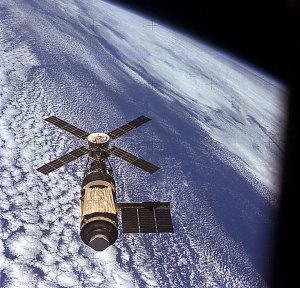 In previous posts I’ve mentioned, albeit in passing, the Apollo Applications Program (AAP) – it was one of the possible applications of the Rogallo paraglider wing after the system was cancelled from the Gemini program in 1964. AAP was the follow-up program to Apollo, the program that would reemphasize science over technology in spaceflight. The program intended to solidify man’s presence in space, expand his understanding of the solar system and the cosmos, and exploit space to satisfy our needs on Earth. This post gives only a cursory overview of the short-lived Apollo Applications Program, but it promises to be the first of many. Over time, I hope to put together a comprehensive picture of the program. (Pictured: Skylab. 1974.)
In previous posts I’ve mentioned, albeit in passing, the Apollo Applications Program (AAP) – it was one of the possible applications of the Rogallo paraglider wing after the system was cancelled from the Gemini program in 1964. AAP was the follow-up program to Apollo, the program that would reemphasize science over technology in spaceflight. The program intended to solidify man’s presence in space, expand his understanding of the solar system and the cosmos, and exploit space to satisfy our needs on Earth. This post gives only a cursory overview of the short-lived Apollo Applications Program, but it promises to be the first of many. Over time, I hope to put together a comprehensive picture of the program. (Pictured: Skylab. 1974.)
It is evident even to those casually interested in NASA’s history that the Apollo Applications Program never gained the momentum its designers had hoped for. The quest for a cost-effective and reusable runway-landing vehicle took precedence over the continued use of Apollo-era systems. The Space Shuttle became the future of manned spaceflight.
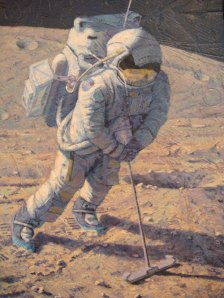 As fascinating and awesome as the Apollo program was, there is some truth behind dissenters’ opinions that the program was little more than a stunt. Cynics are wont to argue that NASA leveraged Americans’ fear of war into an expensive program to one-up an adversary. Certainly there was scientific return from the Apollo missions, but science took a backseat to engineering, and everything was dwarfed by the competition. (Left, Alan Shepard plays golf on the moon in 1971. The portrait was done by Apollo 12 Lunar Module pilot Alan Bean.)
As fascinating and awesome as the Apollo program was, there is some truth behind dissenters’ opinions that the program was little more than a stunt. Cynics are wont to argue that NASA leveraged Americans’ fear of war into an expensive program to one-up an adversary. Certainly there was scientific return from the Apollo missions, but science took a backseat to engineering, and everything was dwarfed by the competition. (Left, Alan Shepard plays golf on the moon in 1971. The portrait was done by Apollo 12 Lunar Module pilot Alan Bean.)
As soon as Neil Armstrong stepped out of the Eagle (Apollo 11’s lunar module) and set foot on the moon, NASA achieved its goal. There were still nine more Apollo missions scheduled, each with different aims hoping to add to the growing knowledge of the Moon as well as men’s ability to live and work in space. But what about after Apollo? What would drive NASA to continue its exploration of space? Would science and technological development for its own sake be enough or would there have to be a new long-term goal to give the organization a sense of purpose.
In an attempt to avoid any period of inactivity, NASA managers had begun planning for the next stage of manned spaceflight years before Apollo reached the moon. The Apollo Applications Program was set to pick up where Apollo left off. NASA shouldn’t miss a beat.
AAP goals were vague, based loosely on a continuation of capacities and experience developed during Apollo. The program’s first quarterly report published in 1968 laid out four major goals for the new program: long-duration space flight for up to 2 months, scientific investigations in earth orbit, “applications in earth orbit” (a vague and unclear goal), and beginning an effective approach to development of future manned space-flight programs.
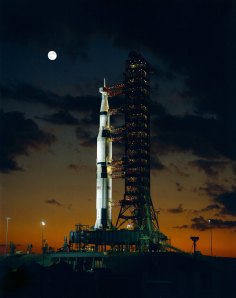 The Apollo Applications Program was established in 1965 as the Saturn-Apollo Applications Office by Associate Administrator for Manned Spaceflight George Mueller. The program was designed to help ensure the Saturn V would be ready for a lunar flight by the end of the decade through risky yet tiimely “all up” testing. Rather than test each piece of the rocket on its own, Meuller urged von Braun to launch a complete rocket. The result was the Apollo 4 unmanned mission (pictured on the launch pad) that successfully delivered an Apollo command and service module into Earth orbit.
The Apollo Applications Program was established in 1965 as the Saturn-Apollo Applications Office by Associate Administrator for Manned Spaceflight George Mueller. The program was designed to help ensure the Saturn V would be ready for a lunar flight by the end of the decade through risky yet tiimely “all up” testing. Rather than test each piece of the rocket on its own, Meuller urged von Braun to launch a complete rocket. The result was the Apollo 4 unmanned mission (pictured on the launch pad) that successfully delivered an Apollo command and service module into Earth orbit.
At the same time, the Saturn-Apollo Applications Office began laying the foundation for the continued application of the mammoth launch vehicle in spaceflight. With the end of decade looming, von Braun knew budget cuts would make jobs scarce. Having an ongoing project would ensure some level of job security for himself and hi workers.
1967 called for the first big missions in the Saturn-Apollo Applications Program. Two launches were planned. One planned to launch the first Apollo crew into Earth orbit, but he Apollo 1 fire in January of that year postponed the first manned flight until October 1968. The second proposed launch would place a workshop in orbit. The workshop was not launched either as there was nothing built to launch. Like Apollo 7, it was postponed.
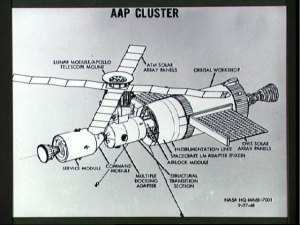 The workshop was the first part of the AAP long-term plan. It was constructed in a reconstituted Saturn S-IVB stage. It would deploy solar panels and provide crews with living and working quarters; missions would come and go from the orbiting lab with the crews using an airlock between the spacecraft and lab. One of the largest planned additions to the orbiting workshop was the Apollo Telescope Mount. Housed in a converted Saturn-IB stage and docked to the Apollo command module, it would be the largest piece of hardware to reach orbit. (Pictured, a proposed configuration of AAP instruments and crew modules.)
The workshop was the first part of the AAP long-term plan. It was constructed in a reconstituted Saturn S-IVB stage. It would deploy solar panels and provide crews with living and working quarters; missions would come and go from the orbiting lab with the crews using an airlock between the spacecraft and lab. One of the largest planned additions to the orbiting workshop was the Apollo Telescope Mount. Housed in a converted Saturn-IB stage and docked to the Apollo command module, it would be the largest piece of hardware to reach orbit. (Pictured, a proposed configuration of AAP instruments and crew modules.)
In addition to the scientific aims, the early AAP missions were also designed to push the limits of the human body in space. The first crew to visit the workshop would stay for 28 days. Subsequent crews, charged with installation of larger pieces to the workshop, would stay for up to 56 days. Long duration missions were in support of eventual long-distance manned flights, such as prospective missions to Mars or an extended stay if NASA ever returned to the moon.
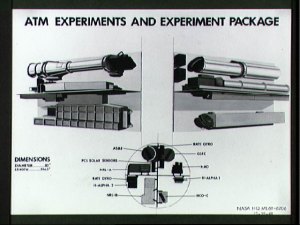 After the workshop, NASA planned to continue the AAP with an additional 45 launched: 26 launches of the Saturn I-B and 19 of the Saturn V. In total, the program expected to place significant flight hardware into orbit including three S-IVB stages for orbital habitation, four Apollo Telescope Mounts, and three more capable workshops. There was early talk of brining the crew home using a pilot-controlled runway landings, but the added weight of the converted Apollo capsule made this an impossibility. Splashdowns were the planned method to bring the crew home. (Pictured, a schematic of the proposed Apollo Telescope Mount.)
After the workshop, NASA planned to continue the AAP with an additional 45 launched: 26 launches of the Saturn I-B and 19 of the Saturn V. In total, the program expected to place significant flight hardware into orbit including three S-IVB stages for orbital habitation, four Apollo Telescope Mounts, and three more capable workshops. There was early talk of brining the crew home using a pilot-controlled runway landings, but the added weight of the converted Apollo capsule made this an impossibility. Splashdowns were the planned method to bring the crew home. (Pictured, a schematic of the proposed Apollo Telescope Mount.)
Following the initial missed launch opportunity in 1967, AAP was given a boost after the successful Apollo 11 mission. In 1969, work began in earnest to get the program off the ground. This time, it was design problem that stalled progress.
The original plan was for the crew aboard the first mission to build the workshop and crew quarters out of the expended S-IVB stage in orbit. Using an expended piece of the launch vehicle would be one less thing to have to launch – it was part of the rocket going into space, why not use it. This plan, however, called for astronauts to live and work in quarters that had recently held fuel.
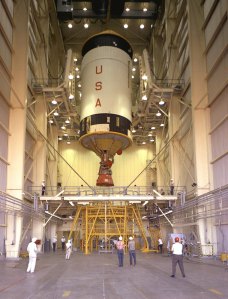 The design was changed to build a workshop out of a clean S-IVB stage. It would be built on Earth and delivered to orbit by the larger Saturn V. Questions then arose as to whether or not there would be any Saturn Vs on hand to deliver something of such size and weight in the aftermath of Apollo. (Right, workers stand in front of a S-IVB stage. This offers a clear illustration of how much room the crew would have to live and work aboard the AAP workshop. 1967.)
The design was changed to build a workshop out of a clean S-IVB stage. It would be built on Earth and delivered to orbit by the larger Saturn V. Questions then arose as to whether or not there would be any Saturn Vs on hand to deliver something of such size and weight in the aftermath of Apollo. (Right, workers stand in front of a S-IVB stage. This offers a clear illustration of how much room the crew would have to live and work aboard the AAP workshop. 1967.)
Adding to its problems were budget cuts; those that killed the last three Apollo missions took a heavy toll on AAP. The program was cut from a long-term expansion of Apollo with a multi-stage orbital installation to a single orbiting workstation. It also underwent a name change. The workshop became Skylab.
The laboratory was launched first and immediately ran into problems when its array of solar panels failed to deploy. Gemini and Apollo astronaut Pete Conrad urged NASA to send a crew up to physically fix whatever was affecting the crippled lab. Two weeks later, he and rookie astronauts Paul Weitz and Joe Kerwin became the first crew aboard the Skylab. They stayed in orbit for 28 days.
Four missions were launched as part of the Skylab program that lasted less than a year; the first mission launched in May 1973 and the last mission splashed down in February 1974.
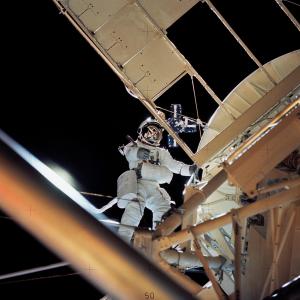
There were other missions proposed and planned as part of the overall Apollo Applications Program such as a manned mission to Venus (a fascinating proposal best discussed on its own). But an extension of Apollo, even with a lofty goal like a mission to another planer, was simply unsustainable for NASA. Without Apollo-era funding, the continued reliance on single-use Apollo-era technologies would have bankrupted the organization. Skylab was the last vestige of the AAP. The joint Soviet-American Apollo Soyuz Test Program (ASTP) was the last mission to use any Apollo-era hardware. The next manned mission after ASTP was the space shuttle (Owen K. Garriott retrieves an experiment from the Apollo Telescope Mount attached to Skylab. 1973.)
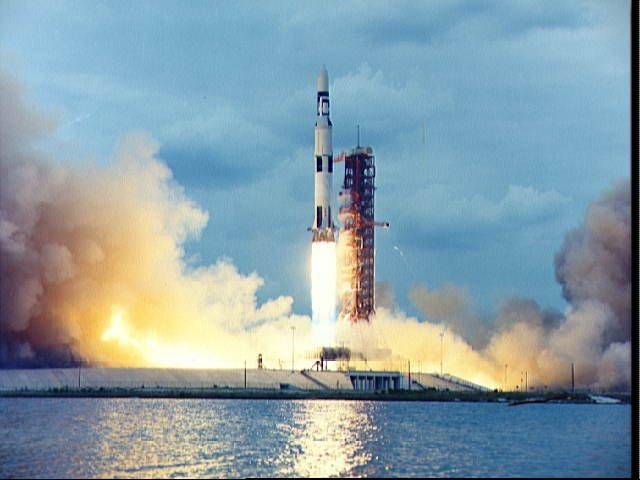
Suggested Reading/Selected Sources
Gerard J. Degroot.“Dark Side of the Moon: The Magnificent Madness of the American Lunar Quest”.
T. A. Heppenheimer. “The Space Shuttle Decision”. NASA History Series. 1999.
Nancy Conrad and Howard Klausner. “Rocketman”. NAL Trade. 2006.
“Apollo Applications Program Quarterly Status Report No. 1” Manned Spacecraft Centre, Houston. NASA. 1968.

“Professional spaceflight historian” – I consider that to be a dream job!
Nice start on documenting the AAP. That program had so much potential. A second Skylab which was never launched, for instance. I wonder if both Skylabs could have been docked (MDAs facing each other) with some sort of intervening structure, which would provide the central axis, and the optimum distance between the decks, for some centripetal, artificial G experiments. Yet, the STS became operational 2 years too late to save Skylab A.
How ironic that the true launch cost of the “reusable” STS was recently released; $1.5 billion, compared to (in 2011 dollars) $1.1 billion for the “expendable” Saturn V. What we could have done with that booster: long-term, LESA outposts on the Moon; manned landings on Mars (using Zubrin’s Mars Direct architecture).
I particularly appreciated the color photo of the S-IVB, and the detailed diagram of the ATM. I await your further postings on the AAP with interest.
Keep up the great work!
-Stu Young